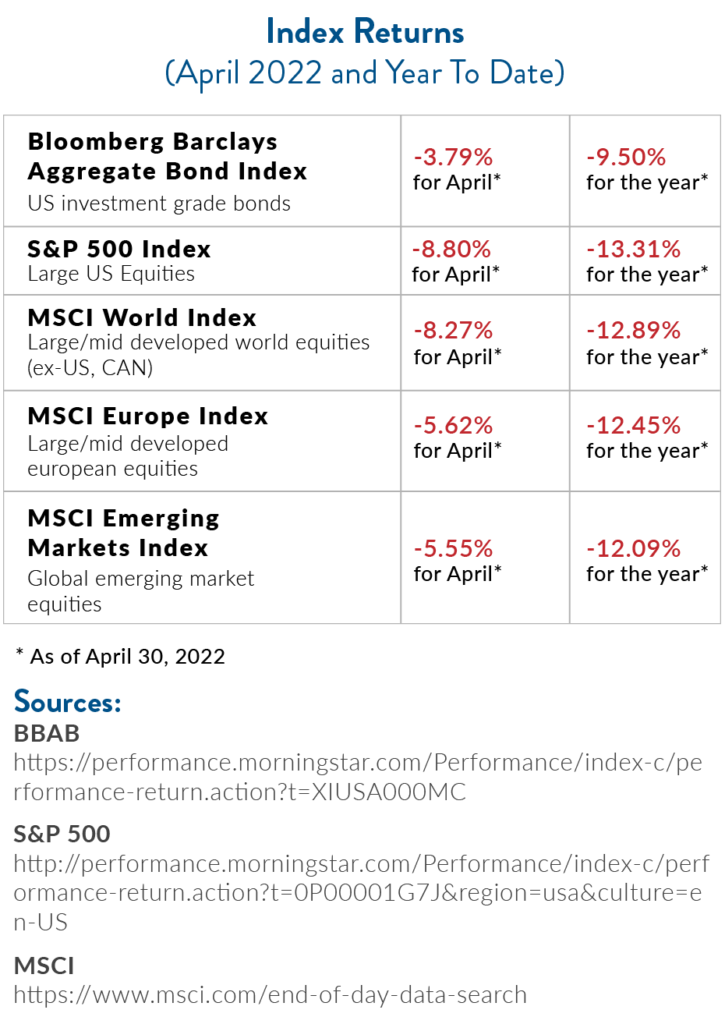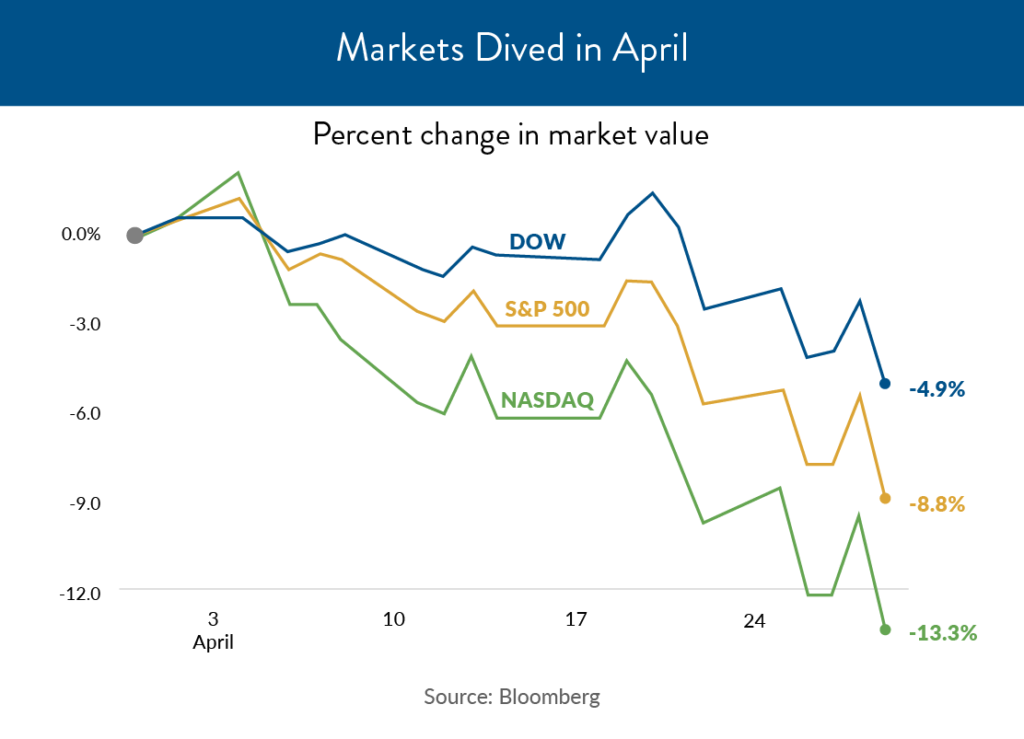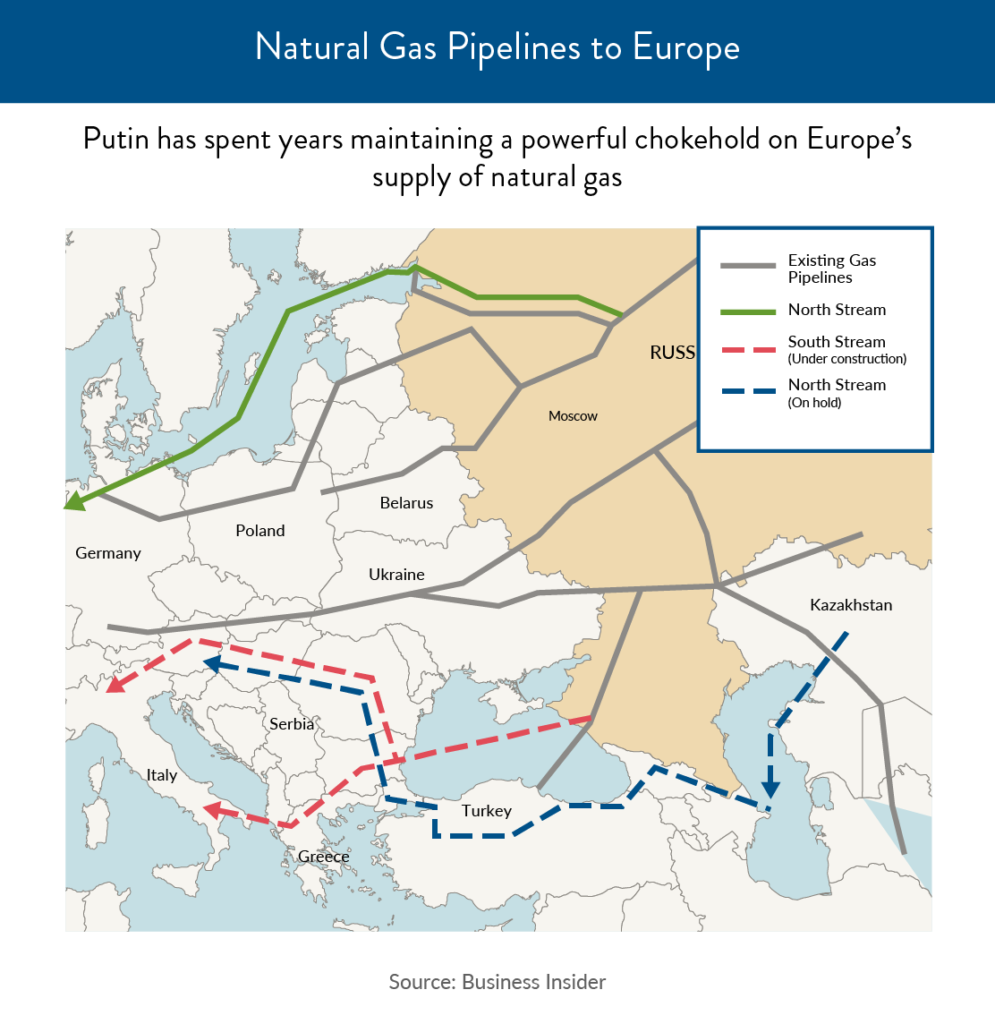Uncertainty Grips Markets: April 2022
After weeks of declines, the S&P 500 equities index had its worst month in April since March 2020.[2],[3] It fell 8.8% and is down over 13% for the year, which is the worst start to a year since World War II.[4] Investors have felt pain across multiple asset classes—bonds suffered the brunt of investor exodus, with world government debt on course for its biggest loss since 1920.[5]
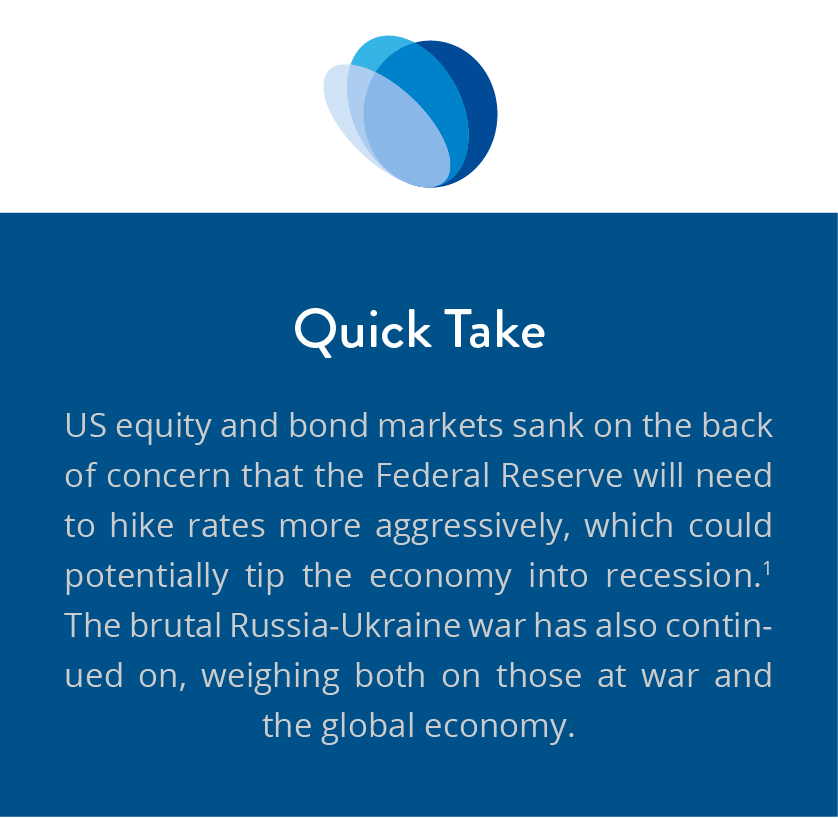 Headwinds ranged from soaring inflation and signs that the Fed is fast-tracking rate hikes, to Russia cutting off fossil fuel to Poland and Bulgaria.[6] Unease about the path of the US economy also brought stocks down from the record levels that began the year.[7]
Headwinds ranged from soaring inflation and signs that the Fed is fast-tracking rate hikes, to Russia cutting off fossil fuel to Poland and Bulgaria.[6] Unease about the path of the US economy also brought stocks down from the record levels that began the year.[7]
A Hawkish Fed Riles Markets
The Fed made a hawkish pivot in an attempt to curb the hottest inflation since 1981.[8] Moving forward, interest rate hikes will be the Fed’s chief tool for combatting higher consumer prices. Just last month, the Fed’s forecast was for fed funds rates (the target interest rate) to reach 2.75% by 2023.[9] Now the market is betting the Fed’s policy rate will be 2.7% by the end of this year.[10] At one extreme, St. Louis Fed President James Bullard declared the need to move quickly and raise rates to around 3.5% by year’s end.[11]
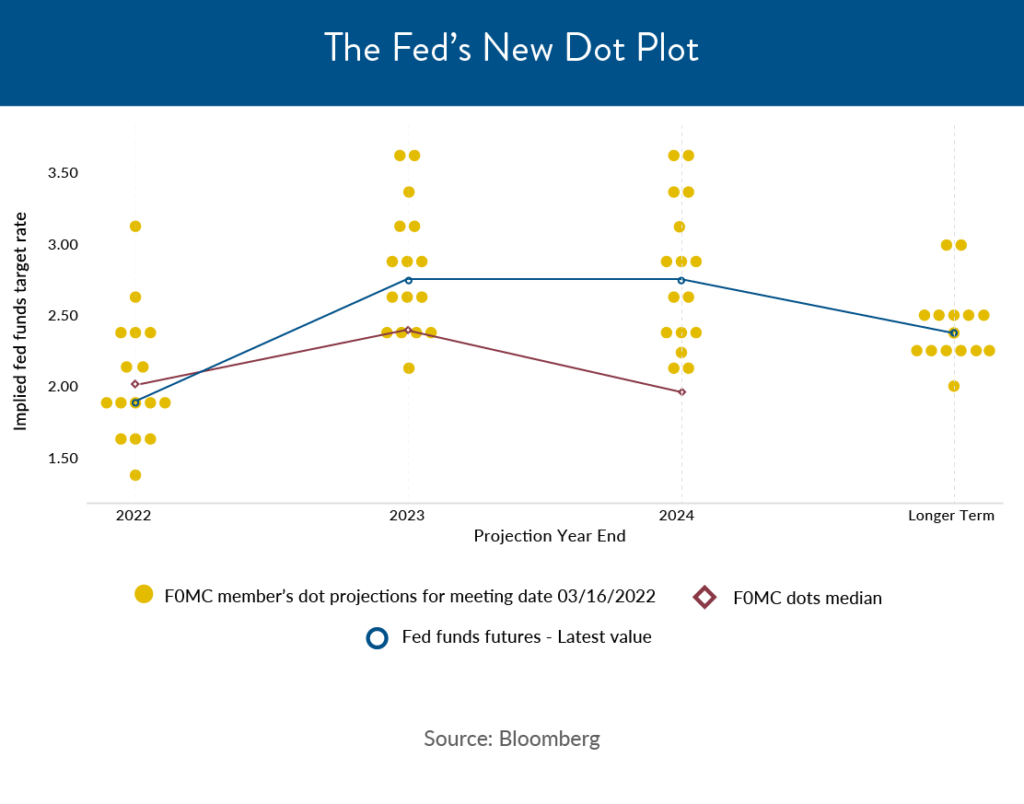
Investors have been dramatically altering their views on how quickly the Fed will hike rates to stamp out inflation.[12] Now, a 0.50% hike is expected for May, with a 0.75% hike likely for June.[13]
When interest rates go up, bond prices fall, and yields go up. As a result, Treasuries sold off (yields went higher), with the 10-year yield close to 3% for the first time since 2018[14]. The iShares 20+ Year Treasury Bond ETF (TLT.O), the most heavily traded bond-focused exchange-traded fund, is down 18% as of Apr 28.[15]
Unpredictable Russia
Looking abroad, Russia’s invasion of Ukraine slogged on for another month. Russia has moved its “depleted and disparate” forces to eastern Ukraine, continuing horrific acts like bombing residential buildings in the capital city of Kyiv.[16]
Some might argue that the events in Ukraine resemble a black swan scenario—a situation where a very low probability event occurs that causes a high level of economic damage. The Russian invasion of Ukraine seemed like talk mere months ago, but as the war drags on, the immensity of the possible fallout, both human and economic, is growing.
The actions of an isolated country with its back against the wall could be very hard to predict. Yet, despite Western economic sanctions—which halted international trade and cut off access to hundreds of billions of Russia’s own dollars—Putin still has economic weapons at his disposal.[17]
Because of its proximity and energy dependence, Europe is experiencing the immediate repercussions of the Russia-Ukraine war. Russian gas meets 40% of Europe’s consumption needs.[18] The European Union also relies on Russia for a quarter of its oil.[19] German Chancellor Olaf Scholz warned that an energy cutoff could plunge “our country and the whole of Europe into a recession.”[20] Global oil prices have hit their highest level since 2008.[21]
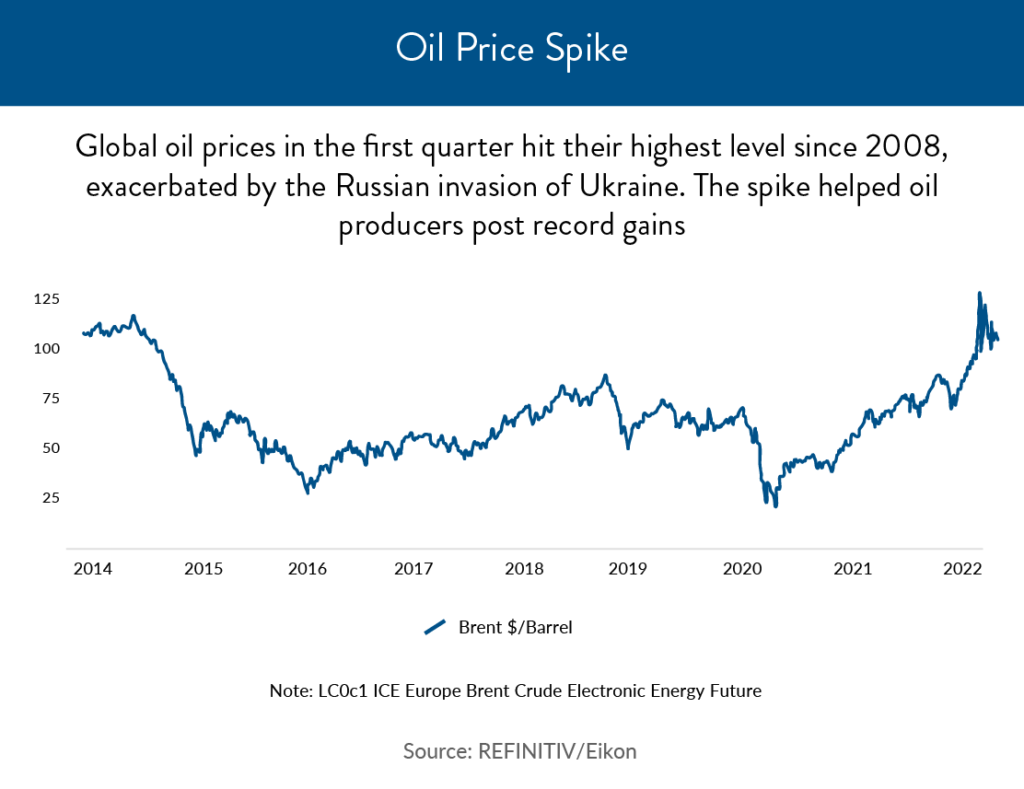
The Russian central bank has been forced to aggressively defend the ruble, its beleaguered currency, which lost half of its value before nearly clawing its way back to levels maintained before the invasion.[22] To defend the ruble, Putin has demanded that “unfriendly countries” pay for natural gas in rubles, which caused the US and Europe to exempt fuel purchases from stringent sanctions.[23]
In the last week of April, Putin shut off gas supplies to Poland and Bulgaria for refusing to pay for gas in rubles, threatening to do the same to other countries.[24] Europe’s benchmark gas contract price jumped by as much as 20% in response.[25] The European Commission accused Moscow of blackmail amid fears of an energy crisis. [26]
What’s Next
The ongoing tragedy in Ukraine remains heavy in our hearts. We are hoping for a timely end to unnecessary bloodshed.
Back home, we’re likely to carry on seeing higher prices and market volatility. As the summer travel season begins, we’ll also see whether or not consumer spending holds up. So far it has, with demand strong enough to outpace inflation.[27] As Goldman Sachs notes, “The strength of consumer incomes and balance sheets remains a key source of economic stability in the year ahead.”[28]
Despite ongoing curveballs, it’s important to remember that corrections are a natural part of the market cycle, especially following record highs. In times of fear and uncertainty, a portfolio managed with your goals in mind may help steer you through the fog.

Please don’t hesitate to call or reach out if you have questions about markets, the economy, key factors, or of course, your portfolio. We appreciate your trust and confidence!
The information expressed herein are those of JSF Financial, LLC, it does not necessarily reflect the views of NewEdge Securities, Inc. Neither JSF Financial LLC nor NewEdge Securities, Inc. gives tax or legal advice. All opinions are subject to change without notice. Neither the information provided, nor any opinion expressed constitutes a solicitation or recommendation for the purchase, sale or holding of any security. Investing involves risk, including possible loss of principal. Indexes are unmanaged and cannot be invested in directly.
Historical data shown represents past performance and does not guarantee comparable future results. The information and statistical data contained herein were obtained from sources believed to be reliable but in no way are guaranteed by JSF Financial, LLC or NewEdge Securities, Inc. as to accuracy or completeness. The information provided is not intended to be a complete analysis of every material fact respecting any strategy. The examples presented do not take into consideration commissions, tax implications, or other transactions costs, which may significantly affect the economic consequences of a given strategy. Diversification does not ensure a profit or guarantee against loss. Carefully consider the investment objectives, risks, charges and expenses of the trades referenced in this material before investing.
Asset Allocation and Diversification do not guarantee a profit or protect against a loss.
The Bloomberg Barclays U.S. Aggregate Bond Index measures the investment-grade U.S. dollar-denominated, fixed-rate taxable bond market and includes Treasury securities, government-related and corporate securities, mortgage-backed securities, asset-backed securities and commercial mortgage-backed securities.
The S&P 500 Index is an unmanaged, market value-weighted index of 500 stocks generally representative of the broad stock market.
SPX, or the Standard & Poor’s 500 Index, is a stock index that is comprised of the 500 largest U.S. publicly traded companies by market capitalization, or the stock price multiplied by the number of shares it has outstanding.
The MSCI World Index is a broad global equity index that represents large and mid-cap equity performance across 23 developed markets countries and covers approximately 85% of the free float-adjusted market capitalization in each country.
The MSCI Europe Index captures large and mid-cap representation across 15 developed markets countries in Europe and covers approximately 85% of the free float-adjusted market capitalization across the European Developed Markets equity universe.
The MSCI Emerging Markets Index captures large and mid-cap representation across 26 emerging markets countries and covers approximately 85% of the free float-adjusted market capitalization in each country.
TLT – iShares 20+ Year Treasury Bond ETF. It seeks to track the investment results of an index composed of U.S. Treasury bonds with remaining maturities greater than twenty years.
By clicking on these links, you will leave our server, as they are located on another server. We have not independently verified the information available through this link. The link is provided to you as a matter of interest. Please click on the links below to leave and proceed to the selected site.
[1] https://www.cnbc.com/2022/04/20/feds-daly-says-the-economy-can-handle-rate-hikes-but-a-mild-recession-is-possible.html
[2] https://www.wsj.com/articles/global-stocks-markets-dow-update-04-29-2022-11651217787
[3] https://www.washingtonpost.com/business/2022/04/29/markets-wall-street-april/
[4] https://www.washingtonpost.com/business/2022/04/29/markets-wall-street-april/
[5] https://www.bloombergquint.com/amp/markets/bofa-s-hartnett-sees-pain-and-exit-if-s-p-500-dips-below-4-000
[6] https://www.cnbc.com/2022/04/20/feds-daly-says-the-economy-can-handle-rate-hikes-but-a-mild-recession-is-possible.html and https://www.npr.org/2022/05/03/1095946919/federal-reserve-inflation-consumer-prices-interest-rate-hike and https://www.reuters.com/world/poland-bulgaria-face-russian-gas-cut-ukraine-crisis-escalates-2022-04-26/
[7] https://www.wsj.com/articles/global-stocks-markets-dow-update-04-29-2022-11651217787
[8] https://www.bloomberg.com/news/articles/2022-04-18/fed-s-bullard-says-75-basis-point-hike-could-be-option-if-needed
[9] https://www.wsj.com/articles/fed-raises-interest-rates-for-first-time-since-2018-11647453603
[10] https://www.ft.com/content/41a62c24-2247-4aeb-b54d-9915b4d8440f
[11] https://www.bloomberg.com/news/articles/2022-04-18/fed-s-bullard-says-75-basis-point-hike-could-be-option-if-needed
[12] https://www.cnbc.com/2022/04/22/markets-are-cranking-up-their-expectations-for-fed-interest-rate-hikes.html
[13]https://www.bloomberg.com/news/articles/2022-04-29/traders-price-near-even-odds-of-75-basis-point-fed-hike-in-june
[14] https://www.ft.com/content/b164866c-90b4-47fc-bf17-8f5b300564e3
[15] https://www.reuters.com/business/finance/us-bond-investors-worry-deep-slide-will-end-40-year-bull-market-2022-04-28/
[16] https://www.cnbc.com/2022/04/29/russia-ukraine-live-updates.html
[17] https://www.nytimes.com/2022/04/02/business/economy/russia-ukraine-sanctions-gas.html
[18] https://finance.yahoo.com/news/1-russias-gazprom-halts-gas-062420279.html?fr=sycsrp_catchall
[19] https://www.nytimes.com/2022/04/02/business/economy/russia-ukraine-sanctions-gas.html
[20] https://www.nytimes.com/2022/04/02/business/economy/russia-ukraine-sanctions-gas.html
[21] https://www.reuters.com/business/energy/chevron-profit-nearly-quadruples-oil-prices-surge-2022-04-29/
[22] https://www.nytimes.com/2022/04/02/business/economy/russia-ukraine-sanctions-gas.html
[23] https://www.nytimes.com/2022/04/02/business/economy/russia-ukraine-sanctions-gas.html
[24] https://www.reuters.com/business/energy/gazprom-says-it-halts-gas-supplies-poland-bulgaria-payments-row-2022-04-27/
[25] https://www.reuters.com/business/energy/gazprom-says-it-halts-gas-supplies-poland-bulgaria-payments-row-2022-04-27/
[26] https://finance.yahoo.com/news/1-russias-gazprom-halts-gas-062420279.html?fr=sycsrp_catchall
[27] https://www.bloomberg.com/news/articles/2022-04-29/u-s-inflation-adjusted-spending-unexpectedly-increased-in-march
[28] https://www.gsam.com/content/gsam/us/en/advisors/market-insights/market-strategy/global-market-monitor/2022/market_monitor_040822.html
Performance table sources:
BBAB: https://performance.morningstar.com/Performance/index-c/performance-return.action?t=XIUSA000MC

